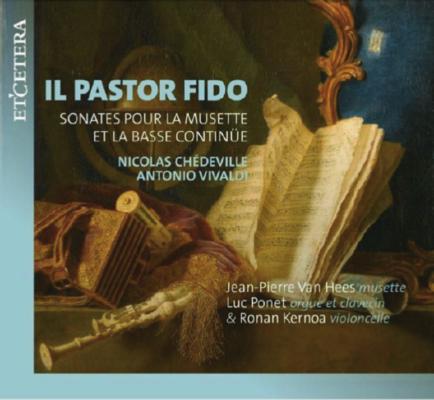The Bagpipe Society
CD Review - Il Pastor Fido
Jean-Pierre van Hees, Luc Ponet, Ronan Kernoa - Il pastor Fido, sonates pour la musette et la basse continue. Etcetera, KTC 1779.

When I first became acquainted with this music, I was introduced to it as a series of recorder sonatas by Vivaldi. But it wasn't written for recorder; it was written for musette. (In true baroque style, recorder players had filched it; and in the notes to the CD, Jean- Pierre delivers a decided rebuke to the pilferers. I plead guilty as charged!)
But the plot thickens; these 'Vivaldi' sonatas are in fact by the musette player, maker and composer Nicolas Chédeville - who mixed in a few portions of genuine Vivaldi to confer a little verisimilitude on his counterfeit. That makes it extremely unlikely that it was intended for any other instrument; as does the fact that the music precisely fits the range of the musette de cour.
The first thing that's evident right from the start is that the playing is nicely articulated. That's important in these pieces, where repeated staccato notes and marked off-beat accents need to be precisely handled. Just a couple of times I found the playing a little too mannered for my taste, for instance in the sarabande of Sonata II; but the bubbling allegro immediately after the sarabande does exactly what it's meant to, including a nicely folky middle section that's reminiscent of the pastoral origins of the pipes.
There are some marked forte/piano dynamic contrasts in the pieces, too, which are not easy to handle with baroque instruments. I have no idea how it's done, but apparently it is possible to play these dynamics on the musette. (I'd suspected some arrangement with the sound recording.)
Ornamentation is an important part of French baroque music (I've spent years trying to get it right, and failing - my recorder teacher says it's because all the English play in Wellington boots!), and I appreciated the subtleties in this recording. Particularly pleasing were some very nice extended ports de voix (long appoggiaturas) in slow movements creating pleasing, discordant suspense.
The instrumentation is interesting. I particularly like the choice of organ accompaniment, with a softer, flutey registration used to contrast against the reediness of the musette. The cello, with its naturally vibrato-rich and resonant tone contrasting with the musette, seemed an odd choice at first, but I liked it more and more as I went on. Chugging cello support for the figuration of the allegro ma non presto in Sonata IV gives it a certain dynamism, and the matching of cello, organ and musette in the Pastorale is quite simply lovely. In fact the whole of this sonata is a highlight; cello and musette matching their articulations perfectly all the way through, a really tight performance.
I did feel, occasionally, that the tempi were a little staid. The performance is exceptionally precise, but I would have liked to have felt there were a few more risks taken, and a little more contrast might have been welcome. I'm used to rather more Vivaldian fire and rather less French restraint in this music.
One thing that I did find quite strange listening to this performance is the effect of the drones on the harmonic language of baroque music. Just occasionally, cadences seem not to have the force they should, as the drones underline a tonic while the music tries to head to the dominant. But that, of course, is what you get if you write baroque music for drone instruments -
Chédeville's fault, not the players'.
I note that Chédeville's thefts (or maybe I should really use the anacronism 'cover versions') from Vivaldi were not limited to Il Pastor Fido. I look forward to Jean-Pierre's recording of the Four Seasons on musette - or rather Les Saisons Amusantes, another fine Chédeville-Vivaldi coproduction!
- Data Processing Notice (GDPR)
-
@BagpipeSociety on X (formally known as Twitter)
-
TheBagpipeSociety on Instagram
-
 BagpipeSociety on Facebook
BagpipeSociety on Facebook
Something wrong or missing from this page? Let us know!
